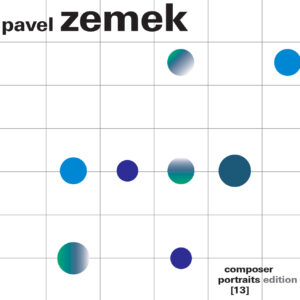Portrait of the composer Pavel Zemek.
Listen to an excerpt on Bandcamp.
Would you like to get this CD? Send us an e-mail.
(*1957)
Pavel Zemek (legal name Pavel Novák) is one of the few composers of whom we can say with certainty that he is marked by an exceptional degree of originality. For years, he has explored the possibilities of the monophony (unison) in pieces ranging from small chamber compositions to extensive orchestral works. During this time, he has also began using predominantly consonant intervals. This results in unspectacularly elegant pieces full of movement, energy, and rhythmic and metric invention – only once we look under the surface do we realise how technically demanding they are. Also characteristic of Zemek is the sonic fullness of his compositions (somewhat unexpected given the chosen compositional method), and, particularly, the strange colour-world – thanks to the reduction to monophony or octaves, we hear the instrumental colours as if in their pure form, “uncoloured” by harmony. As for the intellectual background of the pieces, Biblical themes prevail, even though the music has nothing in common with traditionalist “spiritual” kitsch. Zemek’s oeuvre is extensive and many of his pieces have been performed by significant performers both at home and abroad and published on CD (e.g., in 2011, the British label Champs Hill Records published William Howard’s rendition of the 24 Preludes and Fugues for piano).
Zemek studied composition at the Janáček Academy of Performing Arts in Brno and spent time as an exchange student with George Benjamin in London and Gérard Grisey in Paris. He was previously employed as an oboe player in the orchestra of the Janáček Theatre. Since 1989, he has taught composition at the Brno Conservatory.
The Prophecy of Isaiah. Unison for Seven Instruments (2005)
for flute, clarinet, violin, viola, cello, harp and piano ____ 55:00
- Aria 1 ____4:04
- Aria 2 ____1:17
- Recitativo ____1:41
- Capriccio 1 ____0:53
- Capriccio 2 ____0:49
- Capriccio 3 ____0:54
- Capriccio 4 ____1:49
- Interludio 1 ____2:09
- Interludio 2 ____0:54
- Sintesi 1 (Richard Wagner / Perotinus) ____1:21
- Sintesi 2 (Leoš Janáček / Guillaume de Machaut) ____1:04
- Sintesi 3 (George Gershwin / Johannes Ockeghem) ____1:31
- Sintesi 4 (Francesco Landini / Vincent d ́Indy)____2:16
- Sintesi 5 “Folcloristico“ (Albert Roussel / Jacob Obrecht) ____1:26
- Sintesi 5 – Double 1 “Quasi una danza“ ____1:15
- Sintesi 5 – Double 2 “Quasi un canto“ ____0:57
- Sintesi 6 (Bohuslav Martinů / Josquin des Prez) ____2:14
- Analisi (Josquin des Prez / Bohuslav Martinů) ____1:43
- Sintesi 7 (Otakar Ostrčil / Adrian Willaert) ____2:15
- Sintesi 8, Capricci 1–5 (Erik Satie / Gesualdo da Venosa) ____3:13
- Aria 3 ____2:52
- Sintesi 9 (Max Reger / Andrea Gabrielli) ____1:33
- Sintesi 10, Capriccio – Pizzicato 1 (Jan P. Sweelinck / Alexander Scriabin) ____0:51
- Sintesi 11, Capriccio – Pizzicato 2 (Dietrich Buxtehude / Johann Strauss) ____0:39
- Sintesi 12, Capriccio (Stretto) – Pizzicato 3 (Domenico Scarlatti / Antonín Dvořák) ____0:07
- Sintesi 13, Capriccio – Pizzicato 4 (Georg Friedrich Händel / Bedřich Smetana) ____0:24
- Sintesi 14 (Johann Christian Bach / Hector Berlioz) ____1:04
- Sintesi 15, Giochi ritmici 1–5 (Johannes Brahms / Carl Philipp Emanuel Bach) ____2:06
- Sintesi 16 (Ludwig van Beethoven / Frédéric Chopin) ____1:32
- Sintesi 17 (Franz Liszt culminante / Franz Liszt tardivo) ____3:46
- Sintesi 18 (Franz Schubert / Linea dodecafonica) ____2:00
- Sintesi 19 (Gustav Mahler / Linea degli armonici naturali) ____0:55
- Sintesi 20 (Johann Sebastian Bach / Linea gregoriana e Coda) ____3:12
Brno Contemporary Orchestra
Pavel Šnajdr – conductor
Michal Vojáček – flute, Lukáš Daňhel – clarinet, Lukáš Mik – violin, Stanislav Vacek – viola, Katarína Madariová – cello Ivana Švestková – harp, Stanislav Slavíček – piano

